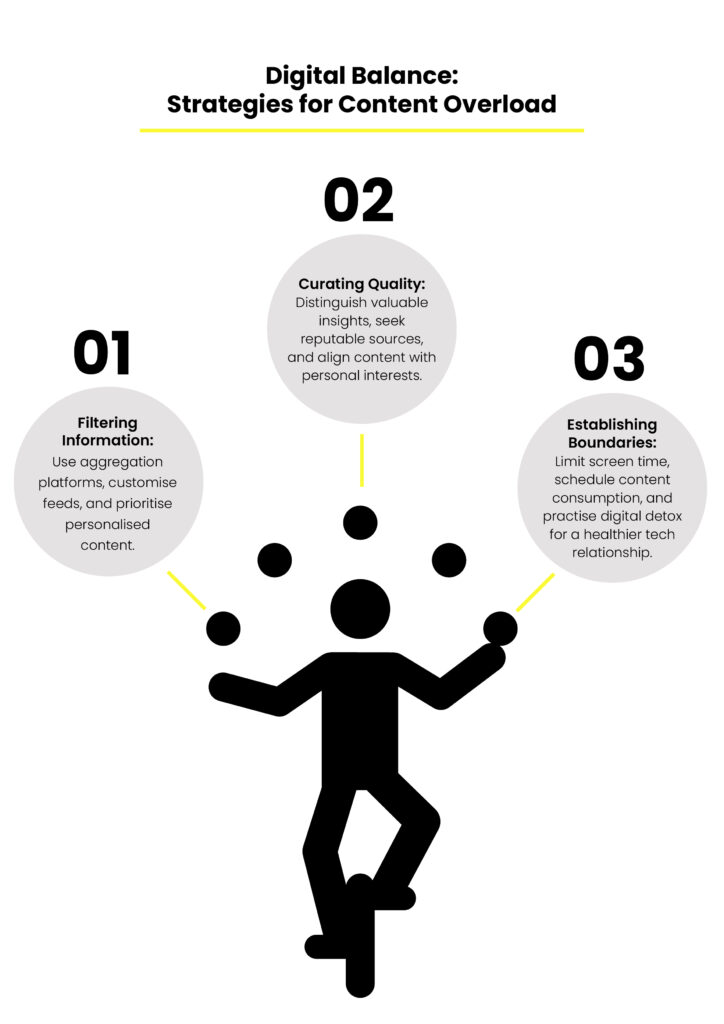In today’s digital age, the term “content overload” has become increasingly common, signifying enough informational abundance available to common users on digital channels. From social media feeds to news websites, we are bombarded with a constant stream of content, often leaving us feeling overwhelmed and unable to keep up. Content overload highlights the tension between quantity and quality in the digital realm, where the sheer volume of information can sometimes overshadow its value and relevance.
In this blog, we delve into the dynamics of informational overload, exploring its implications for consumer attention. Our exploration revolves around dissecting the impact of this phenomenon on how individuals engage with and prioritise content in an environment characterised by an excess of information.
The Rise of Content Overload
From social media updates to online articles, the accessibility and ubiquity of content have fundamentally altered how we engage with information, shaping consumer behaviour in profound ways.
- Explosion of Content Creation: The proliferation of content creation has contributed significantly to the rise of content overload. Factors such as the ease of publishing online, the democratisation of content platforms, and the rise of user-generated content have all fueled this phenomenon.
- Accessibility and Ubiquity: In today’s digital landscape, information is readily accessible and omnipresent. With the advent of smartphones and high-speed internet, individuals are constantly exposed to a perpetual stream of content from various sources.
- Consequences on Consumer Behavior: Content overload has profound implications for consumer behaviour. It can lead to decision paralysis, where individuals struggle to sift through the abundance of options, resulting in indecision or avoidance altogether. Moreover, it can diminish the quality of attention given to each piece of content, leading to superficial engagement & retention.
Navigating Content Overload

To combat the overwhelming tide of content overload, individuals must employ proactive strategies to filter, curate, and establish boundaries in their consumption habits.
- Filtering Information: Strategies for Managing Content Consumption
In the face of content overload, effective filtering strategies are essential for managing information consumption. This involves employing tools and techniques such as using content aggregation platforms, customising social media feeds, and leveraging algorithms to prioritise content based on personal preferences and interests.
- Curating Quality Content: Focusing on Relevance and Value
Amidst the deluge of content, curating quality content is important to maximise material that is of utility. This entails discerning between noise and valuable insights, actively seeking out reputable sources, and prioritising content that aligns with one’s interests, goals, and values.
- Establishing Boundaries: Setting Limits to Prevent Overwhelm
To mitigate the negative effects of content overload, establishing boundaries is crucial. This involves setting limits on screen time, allocating dedicated periods for content consumption. Practising digital detoxes is also a way to cultivate a healthier relationship with technology and information consumption. By implementing these boundaries, individuals can safeguard their well-being and maintain a balanced approach.
Impact on Marketing and Brand Communication
In the digital marketing landscape, navigating content overload presents both a challenge and an opportunity for brands seeking to engage with their audience. Marketers must grapple with the daunting task of breaking through the noise to capture consumer attention amidst a constant barrage of information.
- Challenges for Marketers: Breaking Through the Noise
Marketers face formidable challenges in breaking through the noise of content overload to capture audience attention. With consumers bombarded by a constant stream of information, standing out amidst the clutter requires innovative approaches and strategic tactics. Traditional marketing methods often fall short in this saturated landscape, necessitating a shift towards more personalised, targeted, and engaging strategies to resonate with increasingly discerning audiences.
- Strategies for Cutting Through the Clutter: Embracing Authenticity and Personalization
To effectively cut through the clutter, marketers must embrace authenticity and personalisation in their communication efforts. Authenticity resonates with modern consumers who prioritise genuine connections with brands, making it essential for marketers to convey sincerity in their messaging. Personalisation, on the other hand, enables marketers to tailor content to the specific preferences and interests of individual consumers, increasing relevance and resonance. By combining authenticity and personalisation, marketers can create compelling narratives.
- Leveraging Content Overload to Enhance Brand Differentiation
Instead of contributing to the overwhelming volume of content, brands can leverage content overload to their advantage by focusing on quality over quantity. By understanding the needs, desires, and pain points of their target market, brands can create content that stands out, positioning themselves as trusted authorities in their respective industries. Through strategic content creation and distribution, brands can effectively leverage content overload to differentiate themselves from competitors.
The Role of Technology in Mitigating Content Overload
In combatting content overload, technology plays a vital role. AI and machine learning personalise content delivery, filtering information based on individual preferences. Automation and aggregation tools streamline content consumption, consolidating diverse sources. Yet, ethical concerns arise, emphasising the need to balance efficiency with privacy and transparency. As technology evolves, upholding ethical standards is crucial to ensure user rights are preserved amid the benefits of innovation.
Navigating content overload requires a nuanced understanding of its challenges and opportunities. Key points include the overwhelming volume of information, the need for personalised strategies, and the ethical considerations involved. As brands strive to engage with their audience, prioritising quality and relevance in content creation is essential. Ultimately, the embrace of content consumption in the digital age requires a certain skill that bypasses logic. By leveraging technology, we can proficiently filter and curate content that comes and goes in the digital landscape.